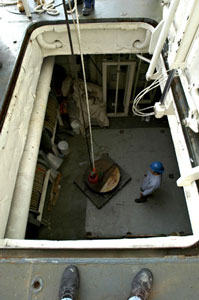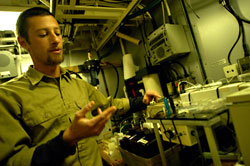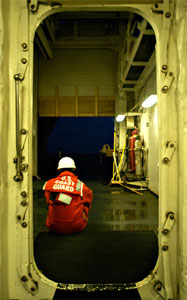 |
 |
 |
| John Kemp and Ryan Scrawder (below) move a 2,700 pound mooring anchor out of the storage hold. My boots are in the foreground. |
| Click
to enlarge |
Daily Update
Calendar
Dispatch 13 - September 22, 2003
By C. A. Linder
Weather conditions: Mostly clear skies, 10 kt winds, 1-2
ft seas, air temperature 35°F
Moving Day
A sliver of moon hung in the clear
morning sky as I strolled the decks this morning. David Leech was
already busy setting up the University of Alaska central channel
mooring instruments on the fantail. Just as the sun cleared the
horizon, the mooring was assembled
and ready to drop into place. David pulled the release and the mooring
sank to the seafloor, collecting data for another year in the Chukchi
Sea.
This afternoon the fantail was a blur of activity as WHOI mooring
technicians John Kemp and Ryan Schrawder brought their mooring gear
out of the cargo hold. They are getting
ready to redeploy the line of eight WHOI
moorings across the "edge of the arctic shelf" --
the steep dropoff into the Beaufort Sea north of Barrow.
This evening I caught up with Dan Schuller as he was analyzing the
nutrient content of the water samples we have been collecting with the Niskin bottles. He uses a machine called
a nutrient auto-analyzer to determine the amount of dissolved phosphate,
silicate, and nitrate in seawater. You can think of these nutrients
as the "fertilizer" for the tiny plants known as phytoplankton
that comprise the base of the marine food chain. The levels of nutrients
are also important in determining where the water came from. This
figure shows the
various currents that flow through the Chukchi Sea - they are color
coded based on the amount of nutrients that they carry. Dan's data is important in
helping us identify how the nutrient-rich Pacific Ocean waters travel across the
shallow Chukchi Sea.
 |  |
| Dan Schuller explains
the operation of the nutrient auto-analyzer. |
| Click
to enlarge |
I have received a number of questions about the weather from Mrs.
Cadwell's 5th grade students at Varnum Brook Elementary
School in Pepperell, Massachusetts.
Question from Jesse: We are looking at Isabel
at this time, how it is affecting us here in Pepperell. Is it affecting
you at all?
Answer: Hi Jesse. No, hurricane Isabel is (thankfully!)
not affecting us here in the Chukchi Sea. It is too far away to
influence our weather. We do keep a close eye on weather, though.
Wind and waves can have a serious imapact on our science. Since
the CTD and moorings are very heavy, when the weather is rough they
become difficult to handle. The Marine Science Technicians on the
ship download weather charts every day, and the ship receives satellite
images via the Terascan system. Every night Marine Science Technician
Daniel Goana or Senior Chief Glen Hendrickson gives a weather brief
to the Captain, Chief Scientist, and ship's officers so that we
can know what to expect the next day.
Question from Mark: Our humidity is very high (93%)
due to Isabel. Does your humidity ever reach those numbers?
Answer: Good question, Mark. Right now our humidity
is 86%. This may seem high, but in reality there is not very much
moisture in the air at all. My hands and lips are quite chapped
from the dry air. So how is it that 86% is "not much moisture"?
Well, it all depends on the temperature. Warm air can hold
a lot more moisture than cold air. Since the Arctic is so cold compared
to the temperate latitudes, it is also very very dry. In fact, it
is considered a desert based on the amount of rainfall
it receives every year. The annual precipitation (rain and snow)
is less than 8 inches. The only place in North America that is drier
than this is the desert southwest (Arizona/New Mexico)!
 |
 |
| Marine Science Technician Bridget Cullers takes a break during a CTD cast. |
| Click
to enlarge |
Pat from Mrs. Cadwell's class at Varnum
Brook asks:
Question: What kind of camera do you have and how do you keep
it from fogging up?
Answer: Hi Pat - be careful! I love talking about
photography and cameras, so I hope this answer isn't too wordy for
you! For these dispatch images I am using a 6 megapixel digital
single-lens-reflex camera body (Nikon D100). The camera is digital,
so I download the pictures to my laptop to review and post to the
website. Single-lens-reflex means that when you look through the
camera you are actually looking through the glass of the lens. The
lenses are interchangeable, and I have a variety of lenses from
wide angle lenses (for taking in the whole
scene) to telephotos (for bringing
those bears closer!) A fogged lens can indeed be a problem.
Usually this happens if the camera gets very cold outside and then
you bring it into a warm, humid room. The warm air then condenses
on the cool surfaces of the camera, including the lens. This can
be avoided by keeping the camera in a case when coming inside -
that way the camera warms up gradually and condensation does not
have a chance to form.
I also received a question from Mrs. Rollo's class at Varnum
Brook.
Question from Ben: Why did the huge jellyfish have
a huge hole in it and why was the woman holding not being stung
by the tenticles.
Answer: Ben, jellyfish like cyanea sp. can in fact deliver a painful sting, but Christina was wearing some very thick rubber gloves, so she was not stung. The hole in the jellyfish was caused by its impact with the CTD instruments.
After we finish tonight's CTD work, it will be full speed ahead
to the WHOI Beaufort Shelf Edge Mooring Array north of Barrow. We hope to
begin the mooring work by Wednesday morning. Thanks for the wonderful
questions - keep em flowing!
 Previous
Dispatch Next Dispatch Previous
Dispatch Next Dispatch

Back to
Calendar
|




